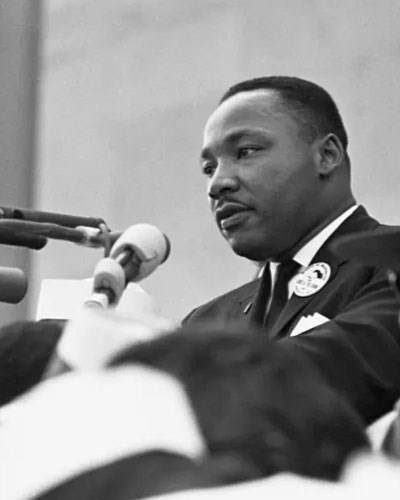
Their relationship often filled with tension, Dr. King was critical to LBJ’s legislative victories, helping push forward the landmark civil rights laws of the 20th century. LBJ Presidential Library Photo. "Make a career of humanity. Commit yourself to the noble struggle for equal rights. You will make a better person of yourself, a greater nation of your country, and a finer world to live in."
Martin Luther King was a sixteen-year-old freshman at Morehouse College when FDR died in 1945, but he had already been inspired by one of the major legacies of the Roosevelt era, Marian Anderson’s historic performance at the Lincoln Memorial in 1939. As a junior in 1944, King represented Booker T. Washington High School in Atlanta at a statewide oratorical contest on the topic of “The Negro and the Constitution.” He spoke movingly of the integrated crowd’s response that “rang out over that great gathering” to Anderson’s renditions of “America” and “Nobody Knows the Trouble I’ve Seen,” noting “that there was a hush on the sea of uplifted faces, black and white, and a new baptism of liberty, equality and fraternity.” But the young King was keenly aware that this “touching tribute” of interracial unity was merely a promissory note. Much work needed to be done as long as “Miss Anderson cannot be served in many of the public restaurants of her home city, even after [Philadelphia] declared her to be its best citizen.” 
National Archives and Records Administration As a young minister with a doctorate in divinity from Boston University, King would call upon FDR’s example at a sermon he gave at his father’s Ebenezer Baptist Church. The 1953 sermon praised notable figures in history who had overcome physical handicaps, such as “Franklin D. Roosevelt, inflicted with infantile paralysis (polio) and yet he rises up to leave such an imprint in the sands of our nation's history, that future history books will be incomplete without his name.” At the inaugural meeting of the Montgomery Bus Boycott in December 1955, he again invoked FDR, earning applause and amens from the congregation for stating that they had “nothing to fear but fear itself.” Eleanor Roosevelt was inspired by King’s leadership, and she admired both the goals and the tactics of the nonviolent crusade the Black minister had launched. She wrote in her syndicated “My Day” column that there “must be great pride, not only among the Negroes but among white people all over the country, in the remarkable restraint and courage shown by the Negroes in their struggle for their rights in Montgomery, Ala., and other places in the South.” ER met with two of the boycott leaders, Rosa Parks and E. D. Nixon, in 1956 and was prominent in the campaign among northern activists to publicize the Montgomery movement. Only a scheduling conflict kept King from meeting with ER at “New York’s Greatest Civil Rights Rally” at Madison Square Garden later that year, where a crowd of over twenty thousand hailed Parks, Nixon, and other leaders of the new southern-based movement. By then, the two leaders had initiated a frequent correspondence that both would learn from and cherish. ER often highlighted her support for King in “My Day.” After his arrest for leading a sit-in demonstration in Atlanta in October 1960, for example, she gave her full support, and typically framed the issue through the broader context of international human rights and America’s place in the world. ER wrote, “The people of the world will condemn—not Georgia, unfortunately—[but] the United States for treating as a criminal a man who is looked upon with respect.” King appreciated ER’s support, writing to thank her “for all you have done, and I’m sure will continue to do to help extend the fruits of Democracy to our southern brothers, please accept my deep and lasting gratitude.” Although in failing health, ER continued to look to new venues to promote the broad goals of human justice that she and King shared. King, indeed, was lined up to talk about civil rights on the first episode of a new television series that she was planning to host, but she was hospitalized and then died on November 7, 1962. In condolence, King wrote the Roosevelt family the next day: “Her life was one of the bright interludes in the troubled history of mankind.” Eleanor Roosevelt would not live to see the March on Washington for Peace, Jobs, and Freedom that A. Philip Randolph and Bayard Rustin organized, and that Dr. King electrified with his “I Have a Dream” speech, ten months after her death. _______________________
Explore the original report, The Roosevelts & African American Civil Rights Leaders, which features in-depth stories and additional leaders. DOWNLOAD THE REPORT |
Last updated: January 15, 2024
